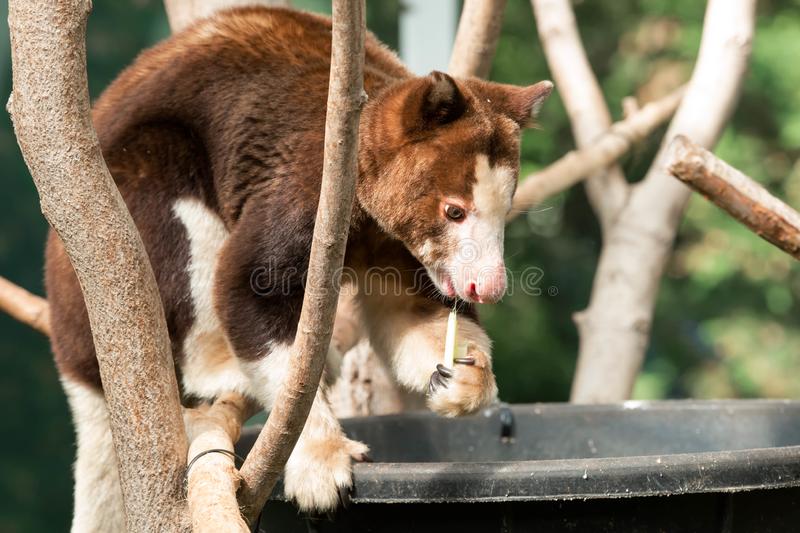ANIMAL: Matschie’s Tree Kangaroo Dendrolagus matschiei Type of Animal: Macropod Habitat: Cloud forest, montane forest, rainforest, deciduous forest Location(s): Huon Peninsula of NE Papua New Guinea Appearance: Reddish-mahogany to reddish-chestnut back, dark stripe down spine, yellow limbs/feet/ear tips, white/cream face, goldish to yellowish belly, stocky body, long tail, curved claws, very unusual-looking marsupial, looks somewhat like cross between lemur & kangaroo Food/Diet: Leaves, flowers, grass shoots, ferns, moss, bark, herbs, orchids, shrubs, fruit, tender grasses, vines, gingers, orchid stems, leafy greens, vegetables, legumes, Timon trees, sap, nuts, roots, tubers, buds, maize/corn, insects, eggs, young birds Status in Wild: Endangered Conservation: Breeding in zoos & wildlife centers. Tree Kangaroo Conservation Program started in 1996 in Seattle area working w/ communities in New Guinea protecting this species & its habitat. Lifestyle: Solitary or male-female pairs Additional Info: Called: Male: Boomer Female: Flyer Young: Joey Group: Pair Weight: Male: 20-25 lbs Female: 15-20 lbs Gestation: 1.5 months Life Span: 15-20 years Height: Male: 2.16 ft Female: 2.06 ft Body Length: Male: 2.16 ft Female: 2.06 ft Tail Length: 2 ft, same for both sexes Main predators are large raptors, dogs, & pythons. Also called Huon Tree Kangaroo & Boongarry. These animals very shy in the wild. These animals can be active at any time. These kangaroos spend 14-15 hours of their day sleeping/resting. Endangered due to habitat loss, deforestation, mining, oil exploration, agriculture, & hunting for food/trade. Due to small ears, these marsupials do not have good hearing. These animals are well adapted for life in trees. Instead of sweating, these animals lick forearms to cool down. Joey stick head out of pouch at 5.5 months & leave pouch at around 10 months. Joey stays w/ mom for another few months. Maturity reached at close to 2 years old. Fur aids in camouflage & insulates animals against damp weather. There are an estimated 2,500 of these animals in the wild. Curved claws aid in traction & grasping. Roughened skin patches aid in gripping/grasping. Fun Fact(s): Best vertical climber of all the tree kangaroos. Typically spring up 2-3 ft to climb trees, wrapping arms around w/ feet pointing against tree, after which kangaroo climbs by sliding/feet hopping. 60% of time spent sleeping. Named after German biologist Paul Matschie. These kangaroos can leap up to 30 ft & can leap down 60 ft.
